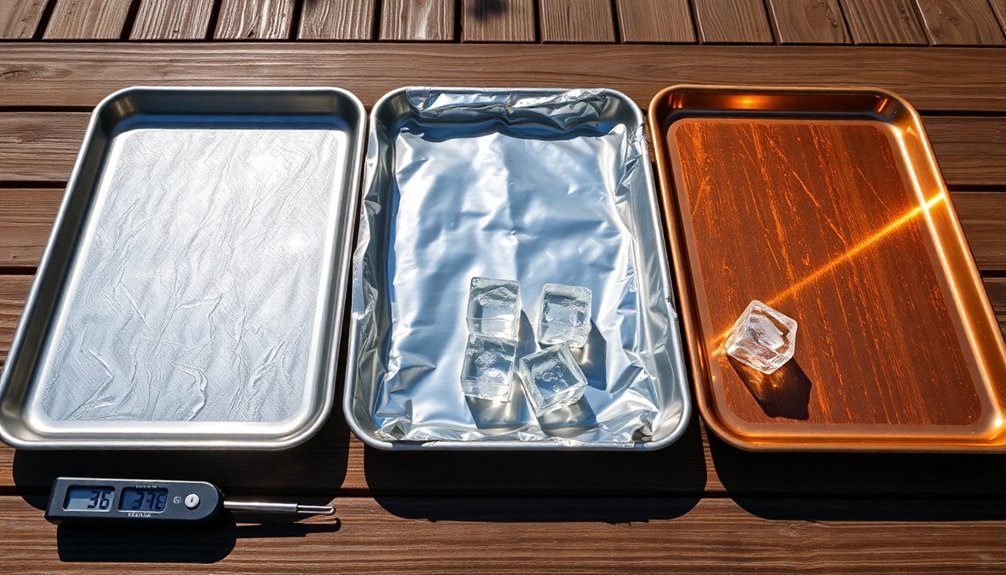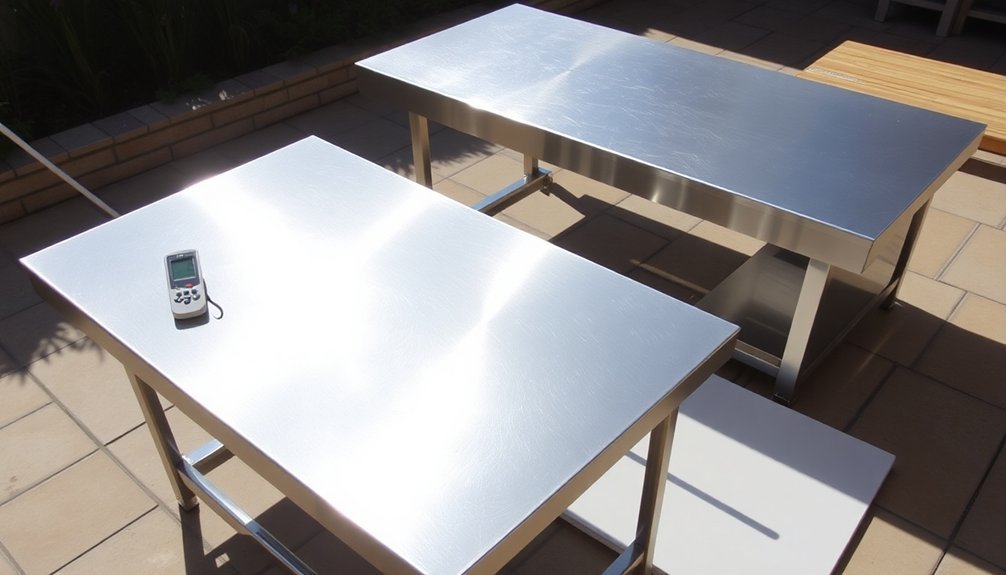When preparing food outdoors, you'll achieve the best results by using materials that effectively reflect and manage heat. Aluminum foil leads the pack with its impressive 95-97% reflectivity rate, while stainless steel offers both durability and excellent heat reflection. For cooking surfaces, natural stones like quartzite and granite provide exceptional heat resistance, and engineered materials such as Dekton combine practicality with performance. You can enhance your setup by incorporating composite materials that reduce heat absorption by up to 35%. There's much more to discover about maximizing your outdoor cooking experience through smart material choices.
Understanding Heat-Reflective Material Properties

When selecting materials for outdoor food preparation spaces, understanding heat-reflective properties is essential for both safety and functionality.
You'll find that aluminum foil stands out for its dual-surface design, featuring a shiny side that reflects radiant heat and infrared light, and a matte side that's less reflective.
While aluminum's heat reflection capability is impressive, you should consider that it's also a good heat conductor, which isn't always desirable. The material's impressive 95-97% reflectivity rate makes it particularly effective for heat management in outdoor cooking areas.
For better durability, look for composite materials that combine aluminum foil with fiberglass or Kevlar.
Natural materials like concrete and stone offer excellent heat resistance but won't reflect heat like metallic surfaces.
If you're concerned about UV exposure, materials like quartz and porcelain maintain their properties without requiring protective sealants.
Aluminum-Based Solar Cooking Solutions
Three key components make aluminum-based solar cooking systems both efficient and sustainable: highly reflective surfaces, smart heat capture design, and durable construction materials.
You'll find that aluminum sheets serve as the primary material in these systems, offering superior reflectivity while remaining cost-effective.
When you combine a solar box with a parabolic dish design, you're maximizing heat capture and retention, achieving up to 58.2W of heating power – enough to boil water and cook various foods. These systems can reach temperatures of up to 900°C, making them capable of not just cooking but also desalinating seawater and smelting aluminum.
To enhance your solar oven's performance, you can incorporate black coated gravel or used engine oil for heat storage.
These locally sourced materials keep your system affordable and accessible.
With proper insulation and regular maintenance of reflective surfaces, you'll have a reliable cooking solution that's both eco-friendly and practical.
Composite Materials for Heat Management

Beyond aluminum-based solutions, modern composite materials offer remarkable heat management capabilities for outdoor food preparation areas.
You'll find advanced composites that reduce heat absorption by up to 35% compared to standard materials, making them ideal for cooking stations and food prep surfaces.
These materials incorporate proprietary polymer technology and innovative core designs that keep surfaces notably cooler than the ambient temperature. For optimal comfort, the technology works especially well in spaces that experience full sun exposure.
You can choose from various color options, with lighter tones providing better heat reflection for your cooking space.
What's more, these composites resist fading from sun exposure and don't require staining or painting, making them practical for long-term outdoor use.
Their solid core construction guarantees durability even in high-temperature environments, while advanced manufacturing processes create uniform temperature distribution across your food prep surfaces.
Durable Heat-Resistant Surface Options
Although outdoor food preparation demands materials that can withstand extreme conditions, several durable heat-resistant surfaces offer exceptional performance and longevity.
You'll find natural stones like quartzite and granite leading the pack, with quartzite being more heat-resistant and requiring minimal maintenance. Immediate spill cleanup is crucial for these materials to maintain their pristine appearance and prevent staining.
Soapstone's non-porous nature makes it ideal for cooking areas, while bluestone provides both durability and aesthetic appeal.
For engineered options, you can't go wrong with Dekton's synthetic blend or porcelain's impressive heat resistance.
If you're seeking a professional-grade solution, stainless steel remains unmatched for its heat resistance and hygiene.
Concrete offers a customizable alternative that's both durable and practical when properly sealed.
Each material brings unique advantages, letting you choose based on your specific needs and preferences.
Maintenance of Reflective Cooking Materials

Maintaining reflective cooking materials requires a thoughtful balance of regular cleaning and protective care. You'll need to use mild detergents with warm water while avoiding abrasive cleaners that can damage the surface. For best results, clean your equipment regularly and dry it thoroughly with a soft cloth to prevent water spots.
- Store your cookware in a dry, ventilated area and avoid stacking pieces to prevent scratches.
- Use silicone or wooden utensils instead of metal ones to protect the cooking surface.
- Apply protective coatings to stainless steel surfaces and buff periodically to maintain shine.
When handling these materials, be mindful of temperature changes and avoid exposing them to extreme heat.
Remember to keep grease build-up in check and never place hot cookware directly on glass or ceramic surfaces.
Frequently Asked Questions
Can Heat-Reflecting Materials Affect the Taste of Food During Preparation?
Heat-reflecting materials won't directly affect your food's taste, but they'll influence cooking temperatures. When you use them properly, they'll help control the rate of chemical reactions that develop flavors during preparation.
How Do Reflective Materials Perform Differently at Varying Altitudes?
You'll find that reflective materials maintain their efficiency at different altitudes, though they'll work slightly better in thinner air. They're more stable in low-humidity conditions but need protection from increased UV exposure.
Are There Specific Cleaning Products That Damage Heat-Reflecting Surfaces?
You'll damage heat-reflecting surfaces if you use water, dry cleaning chemicals, phenolics, or antiseptics. Stick to isopropyl alcohol and neutral detergents, and always clean with a dry microfiber cloth for best results.
What Happens to Heat-Reflecting Properties During Extreme Weather Conditions?
You'll notice heat-reflecting properties decline during extreme weather, as strong winds can damage barriers, direct sunlight causes warping, and moisture leads to corrosion. Even durable materials like concrete can lose some reflective effectiveness.
Do Electromagnetic Fields From Nearby Devices Interfere With Heat-Reflecting Material Performance?
You don't need to worry about electromagnetic fields affecting your heat-reflecting materials. They won't interfere with the material's performance since heat reflection primarily works through radiant heat properties, not electromagnetic interactions.
In Summary
You'll find that properly maintained heat-reflective materials are essential for efficient outdoor food preparation. Whether you're using aluminum-based solutions, composite materials, or specialized heat-resistant surfaces, choose materials that match your cooking needs and local climate. Don't forget to regularly clean and inspect your reflective surfaces to maintain peak performance and extend their lifespan in outdoor conditions.





Leave a Reply